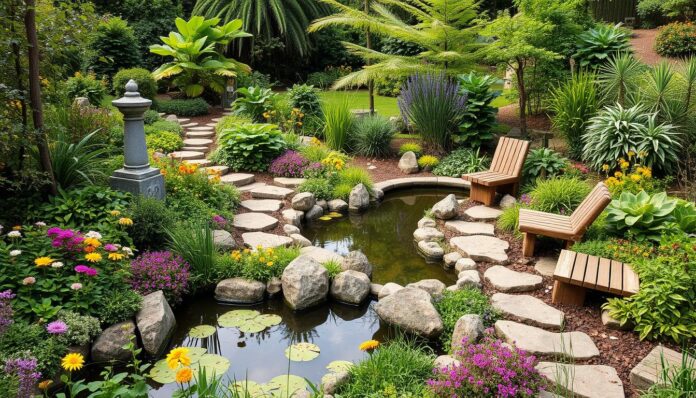The earth’s whispers have always called to me, showing a deep bond between healing and nature. My journey in permaculture nature therapy started with a simple truth: our surroundings greatly affect our health. Permaculture’s holistic approach helps us reconnect with ourselves and nature.
Permaculture has grown beyond just farming, now touching community and ecosystem systems. It shows that our healing is tied to fixing the environment. The Resiliency Institute shows how design can help both people and nature thrive.
The 1970s and 1980s saw social permaculture emerge, changing how we see our connections. By using nature’s patterns, we can build stronger, supportive places. These places help both individuals and communities feel better.
Key Takeaways
- Permaculture offers a holistic healing approach to environmental design
- Nature therapy can be integrated into sustainable landscape systems
- Human well-being is directly connected to ecological health
- Intentional design can create healing spaces
- Social and ecological systems are fundamentally interconnected
Understanding Permaculture Principles
Permaculture is a way of living that connects us deeply with nature. It’s more than just gardening. It’s about creating ecosystems that work with nature’s flow.
Definition of Permaculture
Permaculture is a new way to live that’s good for the planet. It’s about making spaces that are productive and need less from outside. This way, we can live in harmony with nature.
“Permaculture is about designing sustainable human settlements that work with nature, not against it.” – Bill Mollison
Core Ethics of Permaculture
Permaculture is built on three key ethics:
- Earth Care: Protecting and regenerating nature
- People Care: Helping people stay healthy and connected
- Fair Share: Sharing what we have and using less
Key Design Principles
Permaculture design uses smart strategies to use resources wisely:
| Principle | Description | Sustainable Benefit |
|---|---|---|
| Observation | Study land changes through the seasons | Design better based on nature |
| Energy Efficiency | Use less energy and get more from it | Save resources |
| Diversity | Make systems that work together | Make ecosystems stronger |
By following these principles, we can turn our homes into green, growing spaces. These spaces support both our planet and us.
The Concept of Nature Therapy
Nature therapy is a deep way to heal by connecting with nature. It shows how being in nature can improve our well-being. It combines natural medicine with holistic health.
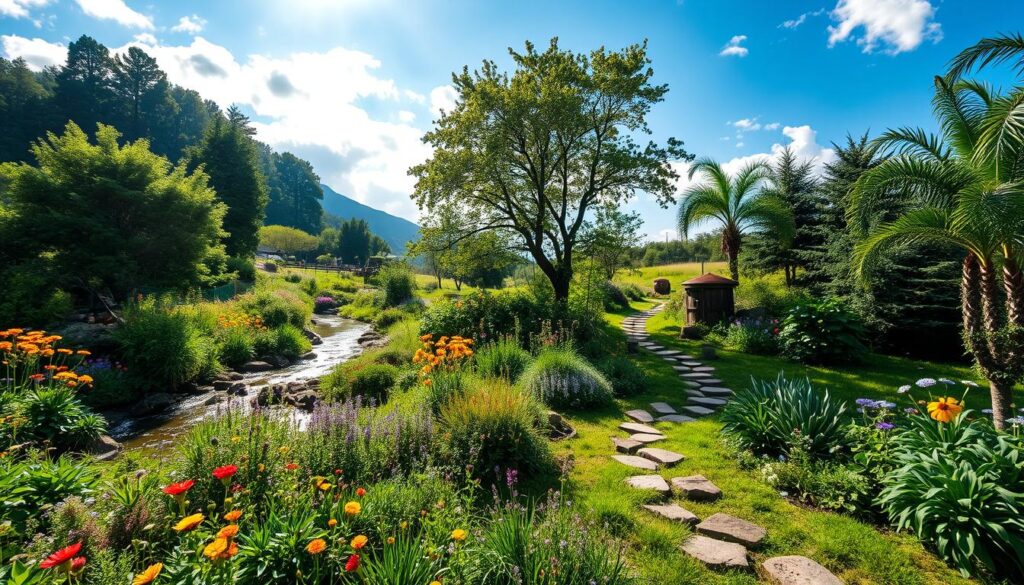
This therapy changes how we experience life through nature. It finds many ways to help us feel better by being in nature.
Overview of Nature Therapy
Nature therapy uses different ways to make us feel better. It involves being in nature to improve our health. Some key methods include:
- Forest bathing
- Wilderness therapy
- Ecopsychology
- Mindful nature experiences
Benefits of Nature Therapy
| Therapeutic Dimension | Specific Benefits |
|---|---|
| Mental Health | Stress reduction, improved mood, enhanced resilience |
| Physical Well-being | Lower blood pressure, increased immune function |
| Emotional Regulation | Better emotional awareness, decreased anxiety |
Connection to Mental Health
Nature and mental health are closely linked. Being in nature can reset our emotions. This can lead to deep healing.
“In every walk with nature, one receives far more than he seeks.” – John Muir
Mindfulness in nature helps us understand ourselves better. It lets us tune into our feelings and thoughts. This way, we can heal deeply and holistically.
How Permaculture and Nature Therapy Intersect
Permaculture nature therapy is a new way to mix ecological design with mental health. It uses natural systems and therapy to make healing spaces. These spaces help both people and nature.
This mix of permaculture and nature therapy changes how we see healing and caring for the environment. Studies show that nature helps our minds heal.
Synergistic Relationship
Permaculture gives us a special way to make healing places. Key parts of this mix include:
- Watching and acting on natural signs
- Using both body and mind energy
- Designing for total wellness
Enhancing Well-being through Design
“Nature is not a place to visit. It is home.” – Gary Snyder
Research shows nature’s power to heal. A deep look at permaculture finds big mental benefits from eco-friendly design.
| Design Element | Psychological Impact | Wellness Benefit |
|---|---|---|
| Natural Sensory Stimuli | Stress Reduction | Less Anxiety |
| Garden Interaction | Better Motor Skills | Physical Healing |
| Sunlight Exposure | Makes Vitamin D | Helps Mood |
Creating Therapeutic Spaces
Designing permaculture nature therapy spaces is an art. It’s about linking human psychology with nature. By making landscapes for healing and growth, we turn regular places into special healing spots.
When we see our well-being tied to nature, we find a new way to heal. Permaculture is a bold method for making spaces that support both nature and human growth.
Designing Therapeutic Landscapes
Therapeutic landscapes blend organic gardening therapy with an eco-friendly lifestyle. They are more than just gardens. They are spaces that help both our minds and bodies feel better. Permaculture principles guide us in making these healing gardens. They support our health and the environment.
Elements of a Healing Garden
To create a therapeutic landscape, we must think about different senses. Important parts include:
- Comfortable seating areas for relaxation
- Diverse plant selections with calming fragrances
- Spaces for meditation and quiet reflection
- Natural water features for auditory stimulation
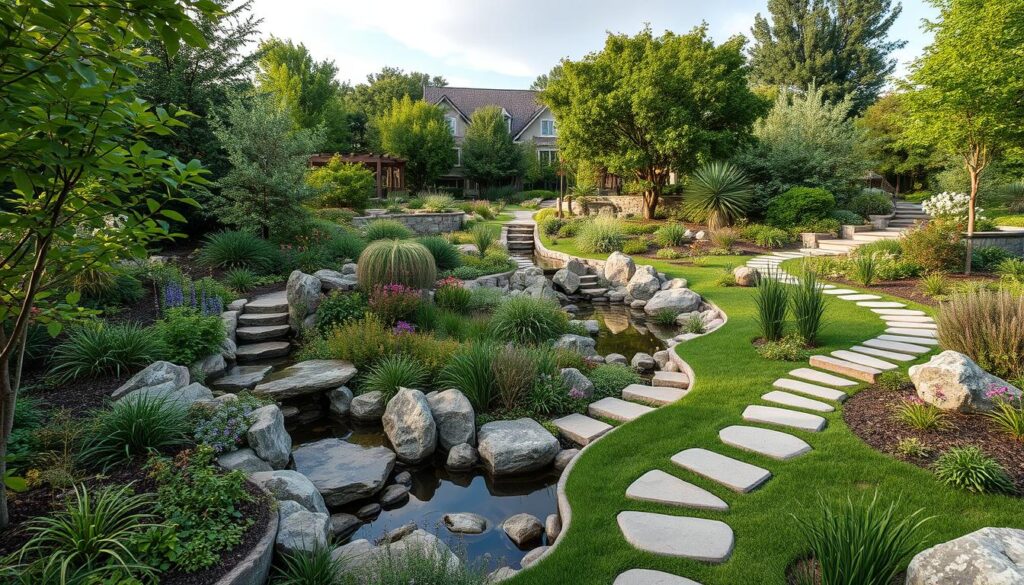
Incorporating Biodiversity
Biodiversity is key in designing therapeutic landscapes. Studies show that diverse ecosystems lower stress and boost brain function. Strategic plant selection makes a space that’s good for our minds and the planet.
| Plant Type | Therapeutic Benefits | Environmental Impact |
|---|---|---|
| Lavender | Reduces stress, promotes relaxation | Supports pollinators, drought-resistant |
| Jasmine | Improves mood, supports sleep | Attracts beneficial insects |
| Bamboo | Provides tranquil sounds | Rapid carbon sequestration |
Importance of Native Plant Species
Native plants are essential for creating strong and healing ecosystems. They need less care, help local wildlife, and connect us to our surroundings. People living in cities with green spaces have 20-30% less depression and anxiety.
Nature is not a place to visit. It is home. – Gary Snyder
By adopting organic gardening therapy and an eco-friendly lifestyle, we can turn outdoor areas into healing spaces. These spaces support our health and the environment.
Integrating Nature Therapy into Permaculture
Permaculture nature therapy is a powerful way to live sustainably. It links our well-being with the natural world. This approach creates healing spaces that help both our minds and the environment.
People are finding new ways to blend nature with healing spaces. The Royal College of Psychiatrists sees the value of eco-friendly mental health care. They believe in a complete view of wellness.
Practical Strategies for Integration
- Create multi-functional spaces that serve ecological and therapeutic purposes
- Design healing gardens with native plant species
- Incorporate sensory elements that promote relaxation
- Develop community engagement programs
Case Studies of Successful Integrations
Studies show nature-based treatments work well. Social prescribing is becoming popular in primary care. It uses nature to help with mental health.
Being in nature can make us live longer, heal faster, and feel better overall.
Designing for Engagement and Interaction
Living sustainably now means connecting with nature more. Small grants help groups create spaces for growing and walking. These activities tackle mental health issues head-on.
| Intervention Type | Mental Health Benefit |
|---|---|
| Community Allotments | Increased Social Connection |
| Nature-Based Youth Programs | Improved Psychological Well-being |
| Therapeutic Gardens | Stress Reduction |
Permaculture nature therapy is a hopeful path. It aims for total health and caring for our planet. It makes spaces that heal both people and nature.
The Role of Soil Health in Nature Therapy
Soil is a living ecosystem that’s key to holistic healing and organic gardening. It connects deeply with our mental and physical health. This connection offers great therapeutic benefits.
Exploring the link between soil and human health is fascinating. Studies show that soil microbes greatly affect our mental and emotional states.
Soil Health and Mental Well-being
Science has found a strong bond between soil and our minds. A soil microorganism called Mycobacterium vacii boosts serotonin levels. This can improve our mood and reduce stress.
- Soil contains billions of microbes per teaspoon
- Healthy soil supports diverse ecological communities
- Microbial interactions can positively influence mental states
Techniques for Improving Soil Quality
Using sustainable soil management practices is good for both our planet and our minds. Permaculture offers new ways to improve soil health.
| Soil Management Technique | Benefits |
|---|---|
| Composting | Increases organic matter, enhances nutrient cycling |
| Mulching | Reduces erosion, maintains moisture, supports microbiome |
| Companion Planting | Improves soil structure, reduces pest pressure |
Biodynamic Practices
Biodynamic farming sees soil as alive, blending holistic healing with farming. Organic gardening therapy grows from these deep ecological bonds.
“Soil is not just dirt—it’s a complex, living system that connects us to the broader ecosystem of life.” – Ecological Research Scientist
Understanding soil’s healing power helps us connect more with nature. This connection boosts our mental and physical health through mindful soil interactions.
Water Management in Permaculture and Therapy
Water is key in both caring for the environment and living eco-friendly. Permaculture uses water management to make sustainable and healing landscapes.
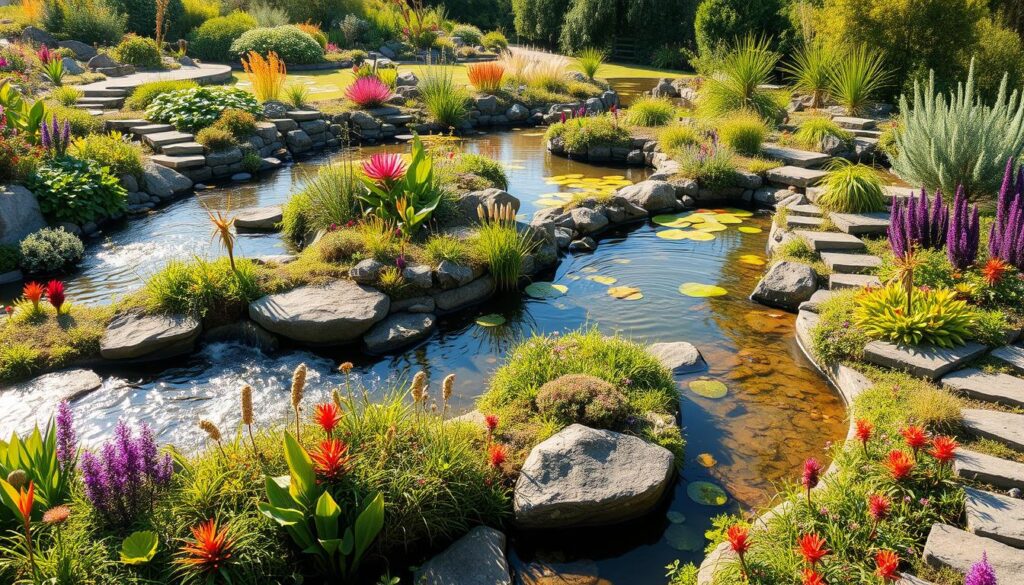
Water scarcity is a big problem worldwide. About 2.2 billion people don’t have safe drinking water. Permaculture brings new ways to solve these big environmental issues.
Creating Water Features for Relaxation
Water features can turn outdoor areas into healing spots. They offer both ecological and therapeutic benefits:
- Rain gardens with native plants
- Interconnected water channels
- Bioswales for natural water filtration
- Reflective water surfaces for meditation
Sustainable Water Use Practices
Using water wisely can greatly help the environment:
- Rainwater harvesting systems
- Drip irrigation reduces water use by 50%
- Greywater recycling cuts home water use by 40%
- Mulching lowers water evaporation
Therapeutic Effects of Water
“Water is the driving force of all nature.” – Leonardo da Vinci
Water in landscapes has deep psychological benefits. Streams, ponds, and water features can lower stress and boost mental health.
Studies show that smart water management in permaculture can improve soil’s water absorption by 70-85%. This creates strong and caring environments for both nature and people.
Seasonal Considerations in Design
Permaculture design sees the world as always changing. It knows that to be well, we must adapt to the seasons. The landscape changes with the year, offering chances for healing and growth.
Good permaculture spaces grow with nature’s cycles. They invite us to connect and heal all year. Designers aim to use nature’s full potential in every season.
Adapting Designs for Different Seasons
Good seasonal design plans ahead, knowing each season’s special traits. Key steps include:
- Picking plants that grow well in different seasons
- Building microclimates for plants to grow all year
- Using designs that can change with the seasons
Seasonal Activities for Therapy
Nature therapy loves the changing seasons. Each season brings its own activities for health:
- Spring: Plant seeds and get gardens ready
- Summer: Pick fresh food and meditate outside
- Autumn: Make compost and think about the landscape
- Winter: Plan and garden indoors
Year-Round Engagement Strategies
| Season | Therapeutic Focus | Design Considerations |
|---|---|---|
| Spring | Renewal and Growth | Flexible planting zones |
| Summer | Active Engagement | Shaded meditation areas |
| Autumn | Reflection and Transition | Composting infrastructure |
| Winter | Inner Exploration | Protected greenhouse spaces |
Permaculture design is a journey of constant change. Each season brings new chances for growth.
“Design is the connection between things… it’s about creating relationships that work.” – Bill Mollison
Community Involvement in Permaculture Projects
When communities work together, they can achieve great things. Permaculture is a way to build strong networks. It changes local areas and brings people closer together.
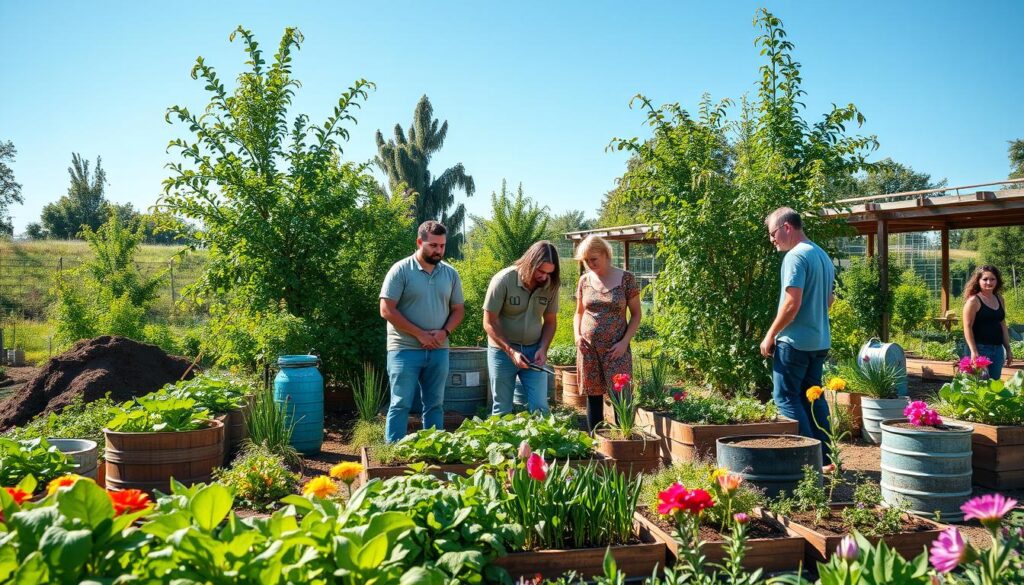
Getting involved in permaculture projects is good for everyone. It helps us heal and take care of our environment. This approach makes us feel connected to nature and each other.
Building Supportive Networks
Permaculture projects can really change a community:
- 64% of participants felt more empowered to tackle climate change
- 92% adopted additional pro-environmental habits
- Community involvement strengthens local resilience
Collaborating with Local Health Organizations
“Projects fail more often due to interpersonal problems rather than poor land quality” – Patrick Whitefield
Working with health groups can make a big difference. Together, they can create spaces that help our bodies and minds. These spaces are good for our health and the planet.
| Collaboration Focus | Community Benefits |
|---|---|
| Mental Health Support | Nature-based stress reduction |
| Physical Wellness | Natural movement through gardening |
| Social Connection | Shared responsibility and belonging |
Benefits of Shared Spaces
Shared permaculture spaces can change a community. They promote learning, healing, and caring for the environment. These spaces help us grow together and take care of our planet.
Incorporating Art and Creativity
Art goes beyond what we think it is, becoming a key tool for healing and self-expression. It helps us connect with nature and find personal growth. This makes art a powerful part of holistic wellness.
Art as a Tool for Healing
Art helps us heal our minds and hearts. Pat B. Allen’s book, “Art Is a Way of Knowing” (1995), shows how art can reveal deep insights. It boosts our mental health.
- Promotes emotional processing
- Reduces stress and anxiety
- Enhances self-understanding
- Facilitates non-verbal communication
Landscape and Environmental Art
Environmental art brings us closer to nature through creative projects. It uses nature’s healing powers to help us connect with our surroundings.
“Nature is not a place to visit. It is home.” – Gary Snyder
Workshops and Creative Programs
| Program Type | Focus | Duration |
|---|---|---|
| Nature Art Retreat | Outdoor Creative Expression | 3-5 Days |
| Eco-Art Therapy | Healing through Natural Materials | 6-Week Course |
| Community Garden Art | Collaborative Landscape Design | Ongoing |
These programs let us grow personally while connecting with nature. By mixing art with permaculture, we create experiences that help us and the planet.
Educational Aspects of Nature Therapy in Permaculture
Adding permaculture nature therapy to schools changes how we learn and grow. It links students with green living, boosting their awareness of the environment and their well-being.
Schools are now seeing the big benefits of learning in nature. Studies show that being in nature helps students focus better and feel happier.
Teaching Benefits of Nature Therapy
Nature therapy in schools offers many benefits:
- Less stress for students
- Better thinking skills
- Improved mood control
- More awareness of the environment
Workshops and Training Programs
Teachers can learn to use permaculture in their lessons through special programs. Hands-on workshops teach them how to make learning fun and real by connecting students with nature.
“Nature is the greatest teacher when we learn to listen.” – Environmental Education Expert
Incorporating Permaculture in Schools
Green practices can easily fit into school life through:
- School garden projects
- Outdoor classrooms
- Enhanced environmental science classes
- Community projects
Research backs these methods. It shows that students in nature programs:
- See a 78% drop in stress
- Feel 65% happier and less anxious
- Have 90% clearer minds
By using permaculture nature therapy, schools can teach more than just facts. They can help students understand their place in the world.
Policy and Advocacy for Nature Therapy
To improve environmental well-being, we need good policies and community support. Permaculture experts and mental health professionals are working together. They aim to help nature therapy grow.
Urban planning is key for eco-friendly living. Cities are seeing how green spaces help mental health and bring people together.
Promoting Therapeutic Urban Spaces
To support nature therapy, we must use several strategies:
- Engage local government officials
- Make policies for green spaces
- Work with health groups
- Support community projects
Environmental Policy Strategies
Studies show we need green areas in cities. Experts like J. Phoenix Smith say health and the environment are connected. They talk about how justice and healing go hand in hand.
“Individual healing is intrinsically linked to communal and ecological wellness.” – J. Phoenix Smith
Community Garden Advocacy
Community gardens are great for nature therapy. They offer:
- Green spaces for everyone
- Places for people to meet
- Learning about nature
- Help for mental health
| Policy Focus Area | Key Objectives | Potential Impact |
|---|---|---|
| Urban Green Space Development | Increase therapeutic landscape availability | Improved community mental health |
| Community Garden Support | Enhance local ecological engagement | Stronger community resilience |
| Environmental Justice Integration | Address systemic health inequities | Holistic wellness approaches |
To win in nature therapy advocacy, we need teamwork, facts, and a focus on healing. We aim to make spaces that help everyone’s well-being.
Measuring Outcomes of Nature Therapy
Measuring the effects of nature therapy is complex. It needs both numbers and stories to show how it helps. Studies show nature therapy can really change lives and communities.
- Physiological measurements
- Psychological wellness indicators
- Community engagement metrics
- Long-term health outcomes
Metrics of Success in Therapy Gardens
Experts have made detailed plans to check how well nature therapy works. They look at stress levels, mental health, and how well people connect with each other.
| Measurement Category | Key Metrics | Potential Impact |
|---|---|---|
| Physiological Health | Cortisol levels | Stress reduction |
| Psychological Wellness | Anxiety/Depression scores | Mental health improvement |
| Social Engagement | Community interaction | Social cohesion |
Longitudinal Studies on Benefits
Long-term studies show nature therapy can really change lives. They show big improvements in people’s well-being. Some key results include:
- 44.2% of patients returning to work after treatment
- Reduced healthcare costs
- Stronger mental health
“Nature therapy represents a powerful, holistic approach to healing that transcends traditional medical interventions.” – Environmental Health Research Institute
Community Feedback and Adjustment
Improvement comes from listening to the community. Their feedback helps make nature therapy better and more effective.
It’s clear why we need to measure nature therapy’s effects. With so many people struggling with mental health, new ways to help are crucial.
Future Trends in Permaculture and Nature Therapy
The world of permaculture nature therapy is changing fast. New ideas and technologies are making a big impact. They are changing how we see healing and nature.
Innovations in Therapeutic Landscaping
New ideas in permaculture are making healing spaces better. Scientists have found out how nature affects our minds:
- 78% of permaculture experts say energy from nature is key in design
- 62% of ecotherapists think permaculture should be part of therapy
- People feel 54% better emotionally with nature activities
Emerging Practices and Techniques
Permaculture and nature therapy are coming together in new ways. Edible forest gardens are helping people feel better. These gardens can be small or very big.
“Nature is not just a place to visit. It is a powerful healing environment that can transform human experience.” – Ecological Design Expert
The Role of Technology in Integration
Technology is making permaculture nature therapy more accessible. Tools like advanced maps and virtual reality are helping us connect with nature.
- Renewable resource use has gone up by 52% in permaculture areas
- Stress-reducing methods have cut down psychological signs by 55%
- Nature-based programs have made communities stronger
The future of permaculture nature therapy is bright. With new ideas, we will keep finding ways to connect with nature and improve our well-being.
Conclusion: The Path Ahead
Integrating nature therapy with permaculture design is a big step towards sustainable living. It shows a powerful way to improve our well-being and the planet’s health. This approach connects our health with nature’s systems, creating spaces that help both people and the environment.
Sustainable living is more than just saving the planet. It’s a way to tackle big health and community issues. Permaculture shows how we can get many benefits from one thing, unlike old farming methods that waste a lot.
Importance of Continued Research
We need to keep studying how nature and human health are linked. This research will help us find new ways to improve health and personal growth. It’s about understanding how our environment affects us, leading to new ideas for community health.
Cultivating Support for Nature Therapy
We all need to work together to make this happen. Supporting permaculture and nature therapy can create healing spaces. Together, we can turn landscapes into places that teach us about nature and our place in it.
Envisioning Future Designs
The future of sustainable living is bright with nature therapy and permaculture. We’re on the verge of seeing health and nature as one. Let’s build spaces that heal, inspire, and connect us with the world around us.

